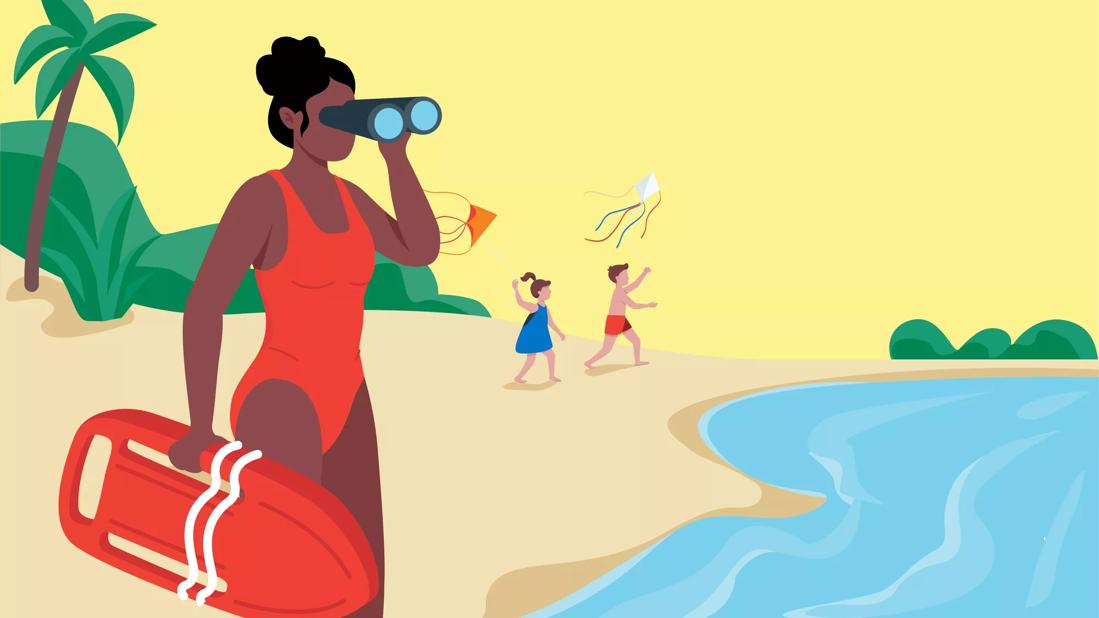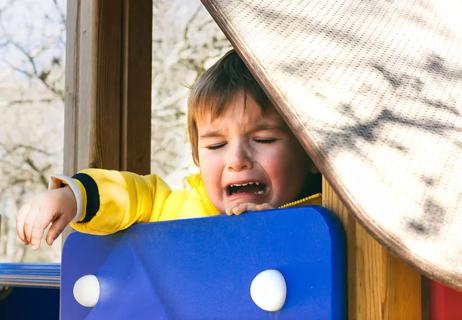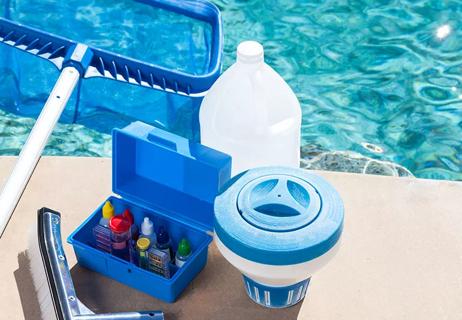From bug bites and blisters to sunstroke and swimming safety, here’s how to stay well this season

Nothing ruins summer fun like a summer injury! Before you pull on your board shorts and head out into the sun, make sure you know how to keep yourself safe, healthy and protected from some of nature’s less forgiving aspects (like the sun itself, not to mention mosquitoes, poison ivy and jellyfish — to name just a few).
Advertisement
Cleveland Clinic is a non-profit academic medical center. Advertising on our site helps support our mission. We do not endorse non-Cleveland Clinic products or services. Policy
To arm you with as much knowledge as possible, we’ve rounded up a few of the summer’s biggest health hazards and shared expert input from healthcare providers. They’ll share how to avoid the risks so you can focus on enjoying the season.
Up to 78% of your body is made of water, so when you don’t get enough of it, you simply can’t function right. In high heat, dehydration can become severe and even fatal.
In the summer, be proactive about staying hydrated, especially if you work outside or play sports. If you start these activities while dehydrated, it’s even harder to replenish what your body has lost.
Trying to figure out how much water you need? It varies by person and depends on your health and activity level, but there are some general rules. “The standard number to aim for is 64 ounces a day,” says registered dietitian Beth Czerwony, RD, LD. Some foods can help hydrate, too.
And keep an eye on the color of your urine, especially when it’s hot out. Pale straw- to dark yellow-colored pee is healthy, while anything darker may be a sign of dehydration.
A sunburn is a radiation burn caused by UV (ultraviolet) ray exposure from the sun. Ouch! You probably know that sunburns contribute to premature skin aging and skin cancer. And in the short term, severe sunburns — the kind that blister and make you feel sick — can lead to dehydration, sun poisoning and infection.
Advertisement
Take preventive measures daily, even on overcast days, by slathering on a chemical or mineral sunscreen that contains titanium dioxide or zinc oxide. Yes, every day. And be thorough: Even if you think you’re a responsible sunscreen wearer, there are still a few spots you may forget to put it on.
“Common places people miss are going to be the ears, your eyelids, your lips, your scalp, the top of your feet or places near the edges of clothing, such as straps,” notes dermatologist Jennifer Lucas, MD.
Dehydration and sunburn aren’t the only risks you run when you spend time in the sun. Both can contribute to other heat illnesses, too:
In addition to staying hydrated and wearing sunscreen, you can avoid heat illness by moderating your time spent outdoors. Take any symptoms you observe in yourself and others seriously — and don’t try to push through them.
“If it’s hot, sunny or humid, take frequent breaks,” advises emergency medicine physician Thomas Waters, MD. “Ideally, get into the air conditioning, but at least into the shade.”
You’re not the only one who loves the warm weather. Bugs do, too! Summertime is high time for:
One of the best ways to keep bugs at bay is to wear insect repellent with the active ingredient DEET (N, N-diethyl-m-toluamide) or picaridin (KBR 3023). Worried about bug spray? Don’t be. Studies show DEET is safe and effective at preventing insect-borne illness.
“Higher concentrations of DEET give you longer-lasting protection if you’re staying outside for several hours,” says dermatologist Melissa Piliang, MD. “Products with DEET typically offer different formulas that contain from 5% to 100% of the chemical, giving you between 90 minutes and 10 hours of protection.”
While it’s not always possible to prevent creepy-crawlies from reaching you, there are other steps you can try:
Advertisement
Sunny days spent on the water are a highlight of summer, but they also present serious dangers for kids and adults alike. In the U.S., drowning is the leading cause of death for kids ages 1 to 4 years old, so it’s important to follow water safety precautions.
There are other related health concerns to know about, too. Shower before and after swimming to avoid getting sick from contaminated pool or lake water, and if you’re headed to the beach, you should probably know the signs of a skin rash called seabather’s eruption.
Side note: Do you know the answer to the age-old question: Should you pee on a jellyfish sting? (Spoiler: No. “You might mean well by peeing on a sting, but putting the wrong substance on it can really make things worse,” Dr. Waters warns.)
Advertisement
Everybody loves a cookout, but cookout foods don’t always love you in return.
Take smoked meats. The very smoking process that gives them their robust flavor also creates harmful substances called polycyclic aromatic hydrocarbons (PAHs) and heterocyclic amines (HCAs). The National Cancer Institute warns that PAHs and HCAs are mutagenic, meaning they can cause changes to your DNA that put you at risk for certain types of cancer.
“As an alternative to smoking, try marinating meats with liquid smoke, then do just a quick turn on the grill or smoker for flavor and effect,” suggests registered dietitian Gillian Culbertson, RD, LD.
Just be sure to cook meats to a safe temperature — and be very careful with cookout leftovers. Foods that sit in the “temperature danger zone” of 40 to 140 degrees Fahrenheit (4.44 to 60 degrees Celsius) start to grow bacteria that are more likely to make you sick. Instead of popping these leftovers in your fridge for later, it’s best to trash them.
Did you know that kidney stones are more common in the summer than in the winter? About 80% of them are calcium-based, and our bodies produce more calcium in the winter. Kidney stones often start to form in colder seasons and reach their peak by summer.
Advertisement
“When warm weather hits, increased temperatures and dehydration lead to further growth of the stones that formed over the winter months,” explains urologist Sri Sivalingam, MD, “and they can suddenly move.”
To try to avoid developing kidney stones, he recommends that you:
Digging in the dirt can be good for your physical and mental health, but it can also result in a sore back, creaky knees, and other aches and pains.
To prevent injuries and next-day discomfort, pay attention to your gardening form: Bend from your knees instead of your hips and adjust your position frequently to take pressure off your joints. Give your body an assist by using ergonomic tools like padded kneelers and wheelbarrows.
And don’t touch that poison ivy! Up to 75% of people are allergic to urushiol, an oily sap found in every part of the plant (and in poison oak and poison sumac, too).
“When the plant is broken, the resin leaks out,” explains dermatologist Pamela Ng, MD. “You’ll get this rash everywhere the resin touches — and then, if you get it on your hands and touch your face or other parts of your body, you’ll spread it.”
Unless you’re wearing sneakers 24/7, the simple truth is that winter shoes are generally more supportive than summer shoes. Flip-flops, wedges and other sandals are all common sources of foot pain and injuries.
“Oftentimes, we see patients trip and fall if they aren’t wearing a supportive shoe,” says podiatrist Joy Rowland, DPM. “They can easily sprain their ankle or stub their toe, among other injuries.”
And then, of course, there are blisters, which always seem to make an appearance when you switch over to your summer footwear. One of the reasons? Sweat.
“If you tend to have sweaty feet, you’re going to be more prone to blisters,” says podiatrist Georgeanne Botek, DPM. Try to keep your skin dry, like by wearing sweat-wicking socks with shoes and by applying a drying agent (like aluminum chloride) to your feet before physical activity.
Bicycle helmets have been shown to reduce the likelihood of a traumatic brain injury by 53% in the event of an accident. Yet 4 out of 5 people don’t wear one when they ride a bike.
Learn how to properly fit a bike helmet, and if you’re not totally sure you’re getting it right, stop into a local bicycle shop to ask for in-person assistance. Plus, wearing your own helmet helps teach kids the importance of wearing theirs, and of bike safety overall.
“You can’t tell your 7-year-old how important it is to wear a helmet and then get on your own bike without one,” Dr. Waters says.
Yes, you can get seasonal affective disorder (SAD) in the summer. It’s most commonly associated with the start of autumn and those increasingly shorter, darker days. But in some people, summer’s arrival can bring the blues.
“It’s less prevalent than winter depression,” notes clinical psychologist Adam Borland, PsyD, “but seasonal depression during the summer is linked to feelings of irritability and frustration. It can result in insomnia and a lack of energy and motivation.”
Contributors can include:
Dr. Borland shares tips for treating summer depression, including establishing a routine, keeping a mood journal and beating the heat whenever possible. And, he says, “It’s also important for people to realize that it’s not a weakness to pursue treatment options.” Need to find a therapist? Here’s how.
Achoo! If your allergies are at their peak in the summer, you’re not alone. In the U.S., about 20 million people have pollen allergies, and hot, humid weather also produces an increase in mold spores.
There’s no cure for seasonal allergies, but keeping this seasonal allergy survival guide in mind will help you endure it relatively unscathed. One of the most important tips? Figuring out the best over-the-counter medication for you and starting to take it well in advance.
“Take medications before allergy season starts,” advises Sandra Hong, MD. “Then, you have your body’s defenses in place when pollen hits — before symptoms become severe and more difficult to control.”
When school’s out for summer, it’s extra important for parents and guardians to stay vigilant about kids’ health and wellness, including teaching fireworks safety, preventing playground injuries and making sure they stay on track with nutrition.
Dr. Sabella shares 10 summer safety tips for kids that cover everything from bug bites and boo-boos to bike helmets and bottle rockets: “Be mindful of the sun, keep an eye on hydration, and keep pool safety and water safety in mind.”
Have a happy, safe and healthy summer!
Learn more about our editorial process.
Advertisement

Breathing in toxic smoke can lead to serious health problems

Watch the weather, keep lines of communication open and make sure everyone on board has access to a personal lifejacket or flotation device

From split lips to splinters, a little first aid can get your kiddo back on the swing set in no time

Breathing in unhealthy air can harm your lungs, heart and more

Establish rules and have a safety plan in place

As temperatures increase, so does the need for safety precautions

Prevent irritation, illness and more by using pool chemicals the right way

Make sure your wood has been split and stored for at least 6 months

Babies can get congested easily, but you can calm their cough by keeping them hydrated, using nasal drops and running a humidifier

Weight loss may cause loose, sagging skin and muscle loss to your rear

Several conditions, like vitiligo and fungal infection, can cause a loss of pigmentation, leading to white spots or patches on your skin